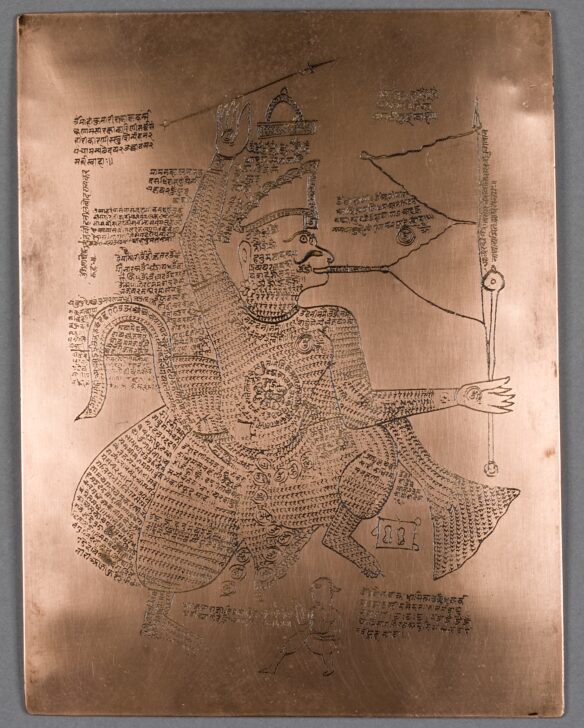Plate Inscribed with Flying Figure of Hanuman Holding a Flag, Mace and Spear
Indian

Description
Plate inscribed with a flying figure of Hanuman holding
a flag, mace, and spear (left)
India, Rajasthan
18th–19th century
Copper
Gift of Dr. and Mrs. Leo S. Figiel and Dr. and Mrs. Steven J. Figiel,
1978/2.89
Durga copper plate (middle)
India, Kulu, Himachal Pradesh
19th–20th century
Copper
Gift of Dr. and Mrs. Leo S. Figiel and Dr. and Mrs. Steven J. Figiel,
1975/2.146
Durga copper plate with mystic design (right)
India, Kulu, Himachal Pradesh
18th–20th century
Copper
Gift of Dr. and Mrs. Leo S. Figiel and Dr. and Mrs. Steven J. Figiel,
1975/2.145
The combinations of divinities with ornamentation in the form
of Hindi letters on these copper plates form yantras, or functional
tools or instruments believed to have talismanic properties. In
India, these mystical diagrams are typically composed of geometric
and alphabetical figures etched onto small plates of gold, silver,
or copper. These devices serve a twofold function: to invoke a
particular god, and to help the devotee focus spiritual and mental
energies upon that deity. They are frequently devoted to the
achievement of health, good fortune, or childbearing, and are
sometimes installed near or under the deity in the temple. In sacred
diagrams such as this one, words enhanced the efficacy of the image,
increasing the divine figures’ protective powers.
The example on the left includes a profile portrait of the monkey-
general Hanuman, who is known to ward off evil portents. The
central and right-hand plates depict the goddess Durga in two
different iconographies. The central image is a fairly conventional
image of the goddess, bearing weapons and sitting atop her tiger
mount. On the right, her appearance is militant and offers the
beholder a fierce and maternal protection: elements of love, care,
and nourishment are present alongside her martial strength. Her
weapons, given to her by the male deities to kill demons they could
not subdue, represent the embodied energies (shaktis) of those gods,
which are here combined in the goddess.
Fall 2022 Gallery Rotation
___________
March 28, 2009
This copper plate presents a profile portrait of the monkey-general Hanuman. His contours have been etched into the plate and filled entirely with ornamentation in the form of Hindi letters. The resulting object is not merely an image, but a yantra—a functional tool or instrument believed to have talismanic properties. In India, these mystical diagrams are typically composed of geometric and alphabetical figures etched on small plates of gold, silver, or copper. These devices serve a twofold function: to invoke a particular god, and to help the devotee focus spiritual and mental energies upon that deity. They are frequently devoted to the achievement of health, good fortune, or childbearing, and are sometimes installed near or under the deity in the temple.
(Label for UMMA South and Southeast Asia Gallery Opening Rotation, March 2009)
Subject Matter:
The monkey Hanuman, often referred to as a monkey god, figures prominently in the epic, the Ramayana, telling the story of the incarnation of Vishnu and his war against the demon king of Lanka, Ravana. He is the most important of the monkey hosts and served important function in the story. He is often sculpted to fit into a set of sculptures depicting the god Rama, the hero of the Ramayana, and his brother Lakshman and his wife Sita. The groups sometimes signify the coronation of the god Rama, which is the end of the story, but sometimes the grouping is of them all standing. He has a devotional following of his own and is usually depicted as a human with a monkey’s head. In this engraving he takes a completely religious role being made up of devotional phrases.
Physical Description:
Hanuman is depicted with a human body and a monkey head. The image is incised on the plate and his body is entirely textured with characters in the devanagari script. Often merely the letter ‘r’ designating the god Rama with whom he is associated. He is in a striding posture and there are a number of sections of text scattered around the image. At his feet is a human figure walking in the opposite direction. He holds a double flag consisting of two triangular shapes facing him in his left hand along with a thin club. One appears to emanating from his mouth? His right hand is lifted with an arrow above it and his tail curves behind him. There is also a small altar depicting the two feet of Rama in the area between his outstretched leg and the end of a scarf wrapped around his body.
Usage Rights:
If you are interested in using an image for a publication, please visit https://umma.umich.edu/request-image/ for more information and to fill out the online Image Rights and Reproductions Request Form.